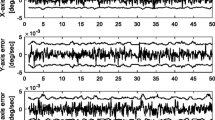My derivation was from ancestors Who stood equivalent to mighty kings
William Shakespeare (1564–1616) and George Wilkins (fl. 1607) Pericles, Prince of Tyre, Act V , scene i
Abstract
The equivalent directions are a set of three unit vectors, conforming to the QUEST measurement model, which can lead in maximum-likelihood estimation to any given attitude estimate and attitude covariance matrix. Since they conform to the QUEST measurement model (i.e., are “QUEST-like”), the equivalent directions can be used not only in general estimation problems but also directly in the Wahba problem. It can be shown that three equivalent directions can always be found, and that they are unique within signs if the eigenvalues of the attitude co-information matrix are non-degenerate, but that the equivalent inverse variances for these equivalent directions may not always be non-negative, hence, not always physically meaningful. This can occur, for example, for attitude covariance matrices computed by the TRIAD algorithm for QUEST-like inputs. The equivalent inverse variances for attitude covariance matrices computed from original QUEST-like measurements will always be non-negative. The connection of the equivalent directions and inverse variances to Markley’s SVD algorithm is presented. While not a practical vehicle for data fusion, the equivalent directions and their equivalent inverse variances can provide a useful tool for the analysis of attitude systems in data fusion problems and in mission design.
Similar content being viewed by others
References
SHUSTER, M. D. “The Generalized Wahba Problem,” The Journal of the Astronautical Sciences, Vol. 54, No. 2, April–June 2006, pp. 245–259.
WAHBA, G. “Problem 65-1: A Least Squares Estimate of Spacecraft Attitude,” SIAM Review, Vol. 7, No. 3, July 1965, p. 409.
SHUSTER, M. D. and OH, S. D. “Three-Axis Attitude Determination from Vector Observations,” Journal of Guidance and Control, Vol. 4, No. 1, January–February. 1981, pp. 70–77.
MARKLEY, F. L. and MORTARI, M. “Quaternion Attitude Estimation Using Vector Measurements,” The Journal of the Astronautical Sciences, Vol. 48, Nos. 2 and 3, April–September 2000, pp. 359–380.
CHENG, Y. and SHUSTER, M. D. “Robustness and Accuracy of the QUEST Algorithm,” presented as paper AAS-07-102 at the 17th Space Flight Mechanics Meeting, Sedona Arizona, January 28–February 2, 2007; Proceedings: Advances in the Astronautical Sciences, Vol. 127, 2007, pp. 41–61.
CHENG, Y. and SHUSTER, M. D. “The Speed of Attitude Estimation,” presented as paper AAS- 07-105 at the 17th Space Flight Mechanics Meeting, Sedona Arizona, January 28–February 2, 2007; Proceedings: Advances in the Astronautical Sciences, Vol. 127, 2007. pp. 101–116.
SHUSTER, M. D. “Maximum Likelihood Estimation of Spacecraft Attitude,” The Journal of the Astronautical Sciences, Vol. 37, No. 1, January–March, 1989, pp. 79–88.
SHUSTER, M. D. “A Survey of Attitude Representations,” The Journal of the Astronautical Sciences, Vol. 41, No. 4, October–December 1993, pp. 439–517.
SHUSTER, M. D. “Effective Direction Measurements for Spacecraft Attitude: II. Predicted Directions,” The Journal of the Astronautical Sciences, Vol. 55, No. 4, October–December 2007, pp. 479–492.
GOLUB, G. H. and VANLOAN, C. F. Matrix Computations, The Johns Hopkins University Press, Baltimore, 1983.
MARKLEY, F. L. “Attitude Determination Using Vector Observations and the Singular Value Decomposition,” The Journal of the Astronautical Sciences, Vol. 36, No. 3, July–September 1988, pp. 245–258.
BLACK, H. D. “A Passive System for Determining the Attitude of a Satellite,” AIAA Journal, Vol. 2, July 1964, pp. 1350–1351.
CHENG, Y. and SHUSTER, M. D. “QUEST and the Anti-QUEST: Good and Evil Attitude Estimation,” The Journal of the Astronautical Sciences, Vol. 53, No. 3, July–September 2005, pp. 337–351.
SHUSTER, M. D. “The TRIAD Algorithm as Maximum-Likelihood Estimation,” The Journal of the Astronautical Sciences, Vol. 54, No. 1, January–March 2006, pp. 113–123.
TANYGIN, S. and SHUSTER, M. D. “The Many TRIAD Algorithms,” presented as paper AAS-07-104 at the AAS/AIAA 17th Space Flight Mechanics Meeting, Sedona, Arizona, January 28–February 2, 2007; Proceedings: Advances in the Astronautical Sciences, Vol. 127, 2007, pp. 81–99.
SHUSTER, M. D. and FREESLAND, D. C. “The Statistics of TASTE and the Inflight Estimation of Attitude Sensor Precision,” presented as paper No. 56 at the NASA Goddard Space Flight Center Flight Mechanics Symposium, Greenbelt, Maryland, October 18–20, 2005.
SHUSTER, M. D. “Constraint in Attitude Estimation Part I: Constrained Estimation,” The Journal of the Astronautical Sciences, Vol. 51, No. 1, January–March, 2003, pp. 51–74.
LEFFERTS, E. J., MARKLEY, F. L., and SHUSTER, M. D. “Kalman Filtering for Spacecraft Attitude Estimation,” Journal of Guidance, Control and Dynamics, Vol. 5, No. 5, September–October 1982, pp. 417–429.
SHUSTER, M. D. “Effective Direction Measurements for Spacecraft Attitude: III. Defective Directions and Data Fusion,” The Journal of the Astronautical Sciences, Vol. 55, No. 4, October–December 2007, pp. 493–510.
Author information
Authors and Affiliations
Corresponding author
Rights and permissions
About this article
Cite this article
Shuster, M.D. Effective direction measurements for spacecraft attitude: I. Equivalent directions. J of Astronaut Sci 55, 463–478 (2007). https://doi.org/10.1007/BF03256536
Published:
Issue Date:
DOI: https://doi.org/10.1007/BF03256536




